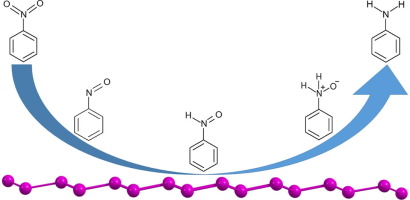Chemical Physics Letters ( IF 2.8 ) Pub Date : 2018-02-09 , DOI: 10.1016/j.cplett.2018.02.027 Christopher Morrissey , Haiying He

|
The reduction of nitrobenzene to aniline has broad applications in chemical and pharmaceutical industries. The high reaction temperatures and pressures and unavoidable hazardous chemicals of current metal catalysts call for more environmentally friendly non-metal catalysts. In this study, the plausibility of silicene as a potential catalyst for nitrobenzene reduction is investigated with a focus on the distinct reaction mechanism based on the density functional theory. The direct reaction pathway was shown to be distinctly different from the Haber mechanism following PhNO2∗→PhNO∗→PhNHO∗→PhNH2O∗→PhNH2∗. The hydroxyl groups remain bound to silicene after aniline is formed and acquire a high activation barrier to remove.
中文翻译:

硅催化硝基苯还原为苯胺的机理研究
将硝基苯还原为苯胺在化学和制药工业中具有广泛的应用。当前金属催化剂的高反应温度和压力以及不可避免的有害化学物质要求更环境友好的非金属催化剂。在这项研究中,以密度泛函理论为基础,以独特的反应机理为重点,研究了硅作为硝基苯还原潜在催化剂的可行性。在PhNO 2 ∗ →PhNO ∗ →PhNHO ∗ →PhNH 2 O ∗ →PhNH 2 ∗之后,直接反应路径与Haber机理明显不同。。苯胺形成后,羟基保持与硅键合,并获得了较高的活化势垒以将其除去。



























 京公网安备 11010802027423号
京公网安备 11010802027423号